Ijraset Journal For Research in Applied Science and Engineering Technology
- Home / Ijraset
- On This Page
- Abstract
- Introduction
- Conclusion
- References
- Copyright
Experimentation on Fabrication of Double Pipe Heat Exchanger
Authors: Durwa Chavan, Pratyusha Joshi, Swapnil Wankhede, Aadarsh Shewale, Dr. Usha Pawar
DOI Link: https://doi.org/10.22214/ijraset.2023.50728
Certificate: View Certificate
Abstract
A heat exchanger is a piece of equipment designed to transfer heat from one medium to another efficiently. It relies on the conduction, convection, and radiation principles with fluids flowing against one another. There are many other forms of heat exchange, but we choose the double pipe heat exchanger since it has two pipes (outer pipe with cold fluid and inner pipe with hot fluid). The goal is to maximize the rate of heat transfer while monitoring the mass flow rates of the two fluids. In order to achieve this, we placed washers between the outer and inner pipes at a certain distance, which would lower the speed of the cold fluid and increase the efficiency of the heat transfer rate. They are extensively utilized in power plants, chemical and petrochemical facilities, oil refineries, sewage treatment facilities, air conditioning, refrigeration, and space heating systems. A heat exchanger is most commonly seen in internal combustion engines, where engine coolant circulates through radiator coils as air passes by, cooling the coolant and heating the incoming air.
Introduction
I. INTRODUCTION
A heat exchanger is a device that exchanges heat between two fluids that are separated by a solid wall and are at different temperatures. This heat transmission is achieved by the temperature gradient or temperature variations. Radiation, conduction, and convection are the three primary techniques through which heat is transferred. Radiation is involved in the utilization of heat exchangers. Radiation does not have a significant impact compared to conduction and convection, though. As the heat from the hotter fluid goes through the solid wall, conduction takes place. To enhance heat transfer, the wall should be thin and made of a highly conductive material. Convection plays a major role in a heat exchanger's ability to transmit heat.
One of the most basic forms of heat exchangers is the double-pipe heat exchanger. Due to the fact that one fluid runs within one pipe and another fluid flows between that pipe and another pipe that surrounds the first, it is known as a double-pipe exchanger. Concentric tubes are used to make this. There are two flow configurations: co-current and counter-current. Co-current is when the flow of the two streams is in the same direction, and counter-current is when the flow of the two streams is in opposing directions. A double-pipe heat exchanger allows for either co-current or counter-current flow.
Inlet temperatures, flow rates, fluid properties, fluid composition, etc., as well as the quantity of heat transmitted, all vary inside the pipes. The process temperatures shift as a result of this transitory behaviour, eventually causing the temperature distribution to stabilize. The temperature of the fluids varies when heat starts to be conveyed. These temperatures are time-dependent until they reach a stable state.
In this double-pipe heat exchanger, hot fluid flow moving through the inner pipe transfers heat to cooling water moving through the outer pipe.
Until a condition, such as the flow rate or inlet temperature, changes, the system is in a steady state. The temperature distribution varies as a result of these conditions changing over time until a new steady state is reached. Once the process and coolant fluid's inlet and outlet temperatures are stable, the new steady state will be observed. Although the temperatures will never be totally constant in practice, a relatively steady state can be experimentally demonstrated when the inlet temperatures or flow rates are changed sufficiently.
A. Heat Augmentation Techniques
In general, the techniques for heat transfer enhancement can be divided into two categories:
- Active Method
Active method, it employs additional power from outside sources, which include mechanical aids, surface-fluid vibration, fluid injection and suction, jet impingement, and electrostatic fields.
2. Passive Method
The alternative option is the passive method, which does not require the use of external power. Surface coatings, wavy surfaces, rough and extended surfaces, convoluted (twisted) tubes, liquid and gas additives, turbulators (coil wire, conical ring, and conical nozzle), and swirl/vortex generators (twisted tape, helical screw tape, axial /radial guide vane, tangential inlet nozzle, and snail entrance) are all part of the passive method. Swirl/vortex flow devices are a type of passive enhancement technology. Twisted tape is one of the most important members of this group, and it is widely used in various heat exchange systems, including solar water heaters, heat exchanger systems, refrigeration systems, and the chemical process industry.
3. Compound Method
This approach incorporates both of the previously mentioned methods at the same time, resulting in a higher improvement in heat transmission than either method employed alone. It combines the benefits of passive and active strategies.
B. Problem Definition
- The problem at hand is to create a heat exchanger that can transfer heat from a higher temperature fluid to a lower temperature fluid.
- The design should seek to increase heat transmission while minimizing the overall dimensions of the exchanger to create a more compact unit.
- The heat exchanger must address fouling and corrosion issues, which can affect its efficiency and longevity.
- The goal is to develop a highly efficient and long-lasting heat exchanger that meets all of these standards while also providing reliable, efficient performance.
C. Objective Of The Project
The enhancement of heat transfer in a heat exchanger is widely applied in industries due to the need for a more compact heat exchanger, a lower operating cost, energy savings, as well as ecological benefits. Inducing washers with different slot configurations can be used as heat transfer enhancement devices in heat exchangers. Effects induced are
- To increase heat transfer rate.
- To increase the heat transfer coefficient.
- To reduce the size of the heat exchanger.
- To reduce floor area.
D. Scope Of The Work
The main goal of this research is to reduce the thermal resistance and improve the performance of thermal devices. Among various studies, passive heat transfer enhancement using twisted tapes has significantly shown good results. In our study, we developed an experimental facility to observe the heat transfer properties of forced convection heat transfer through a circular tube with washers having different slot geometries used as an insert where the fluid was passed at various flow rates.
II. LITERATURE REVIEW
Ahire, S., Shelke, P., Shinde, B., & Totala, N. (2014). Fabrication and analysis of counter flow helical coil heat exchanger. International Journal of Engineering Trends and Technology (IJETT)–Volume, 15(5), 229-240. [1] Helical coils are efficient at a low Reynolds number due to secondary flow development, which enhances heat transfer rate. Wilson plot technique was used to determine heat transfer coefficient.
Sivakumar, K., & Rajan, K. (2015). Experimental analysis of heat transfer enhancement in a circular tube with different twist ratio of twisted tape inserts. International Journal of Heat and Technology, 33(3), 158-162. [2] This study measured heat transfer, Reynolds number, and friction factor in a concentric tube with twisted tape inserts. Results showed that the mean temperature of the twisted tube was increased from 2 to 4% compared to plain tube.
Jamra, S., Singh, P. K., & Dubey, P. (2012). Experimental analysis of heat transfer enhancement in circular double tube heat exchanger using inserts. International Journal of Mechanical Engineering & Technology (IJMET), 3(3), 306-314. [3] This study measured heat transfer, Reynolds number, and friction factor in a concentric tube with twisted tape inserts. Results showed that the mean temperature of the twisted tube was increased from 2 to 4% compared to plain tube.
B K, Anand & Naveena, H.S. & Nagesh, R. & Cg, Prabhakar. (2017). Experimental investigation for the heat transfer of a double pipe heat exchanger. International Journal of Mechanical Engineering and Technology. 8. 203-210. [4] The researchers conducted an experiment to evaluate the performance characteristics of a double-pipe heat exchanger with a high thermal conductivity coating and pure copper pipes. Specific numerical results are not provided.
Mahato, S. K., Rana, S. C., & Barman, R. N. (2021, April). Study of heat transfer enhancement through the non-circular ducts using three dimensional numerical investigations and their comparisons. In IOP Conference Series: Materials Science and Engineering (Vol. 1128, No. 1, p. 012037). IOP Publishing. [5] The study investigated methods for enhancing heat transfer in equilateral triangular ducts. It was found that the twisted hexagonal model enhanced more heat transfer than the twisted square duct for certain Reynolds numbers. Non-circular ducts, such as hexagonally twisted channels, straight square ducts, and CW-CCW twisted square channels, can be effective in enhancing heat transfer for both laminar and turbulent regimes.
A. Major Findings of Literature Review
The study's main findings indicate that incorporating double counter twisted tape inserts in a circular tube significantly improves heat transfer, friction factor, and thermal enhancement efficiency when compared to plain tubes. The study also reveals that as the twist ratio decreases, the efficiency of heat transfer and thermal enhancement increases, while the friction factor decreases. Furthermore, the use of nanofluids and increasing nanoparticle volume concentration enhances convective transfer of heat and increases the average Nusselt number. In addition, single twisted tape outperforms triple twisted tape and twisted tape with circular rings in terms of thermal performance factor. The study concludes that fluid flow disturbances at both the core and surface of the fluid flow are important for improving thermal performance in a heat exchanger. Finally, the use of nanofluids results in a higher thermal performance factor, indicating improved overall performance in terms of heat transfer and friction.
III. METHODOLOGY OF PROJECT
A. The Basic Approach to Using CFD
Computational Fluid Dynamics (CFD) is used as a tool for the evaluation of solutions to fluid flow problems by means of computer simulation. It involves a set of partial differentiation equations describing conservation laws for the transport of mass, momentum and energy.
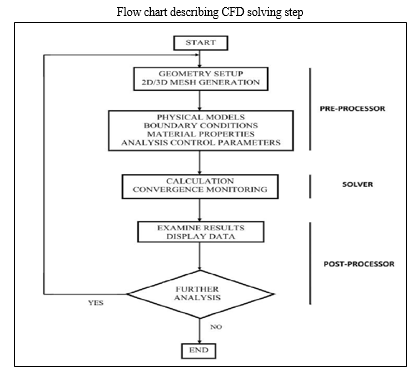
B. Pre-Processor: Establishing the model
- Identify the process or equipment to be evaluated.
- Represent the geometry of interest using CAD tools.
- Use the CAD representation to create a volume flow domain.
C. Create A Computational Mesh In The Flow Domain Solver
- Identify and apply conditions at the domain boundary.
- Solve the governing equations on the computational mesh using analysis software.
D. Post Processor
- Interpreting the results Post-process, the completed solutions to highlight findings.
- Interpret the prediction to determine design iterations or possible solutions, if needed
- Analysis and display of results.
E. Mathematical Model
In order to simulate the flow and heat transfer characteristics of Double pipe heat exchanger, k-? RNG turbulence model with enhanced wall heat treatment is used. Considering some simplifying assumptions, the mechanism that governs fluid flow and heat transfer is due to the conservation of mass, momentum and energy. The energy and turbulence models are considered for capturing the fluid flow and thermal behaviour of the double pipe heat exchanger. These assumptions and equations for incompressible flow are discussed in this section.
F. Assumptions
- Flow is considered to be steady and incompressible.
- All the walls have no-slip momentum conditions and adiabatic conditions applied for all other walls being insulated.
- The pressure force and viscous force alone drive the flow.
- No source terms are included in the model.
- No phase change and no heat generation within the heat exchanger.
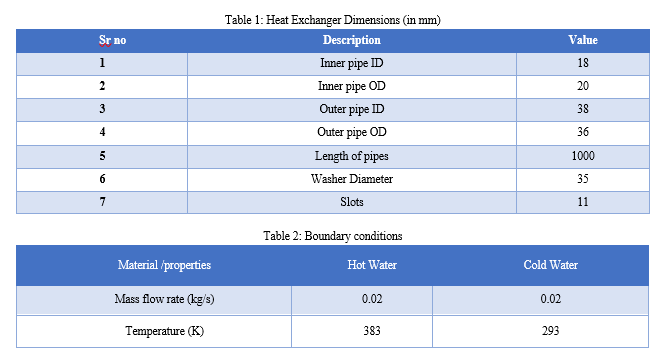
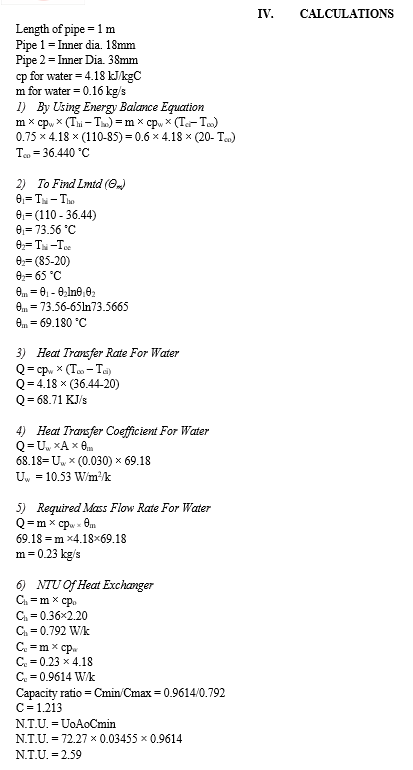
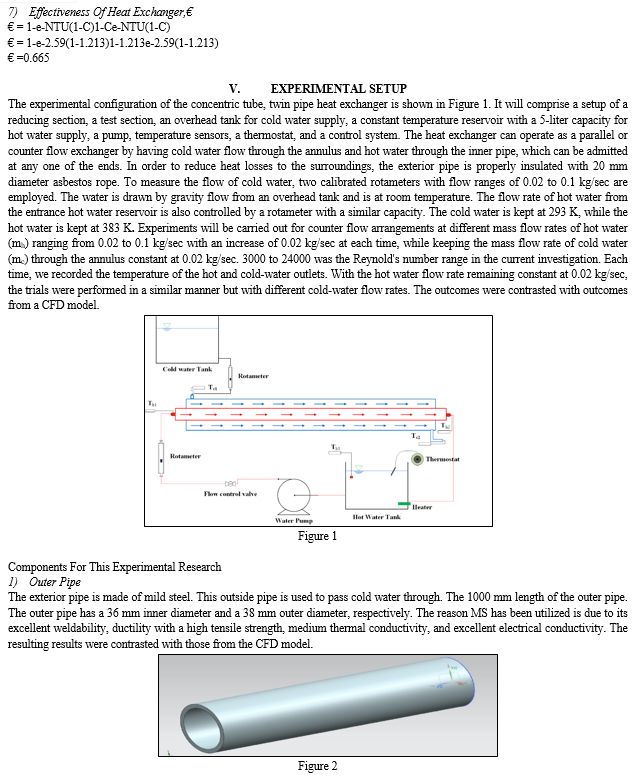
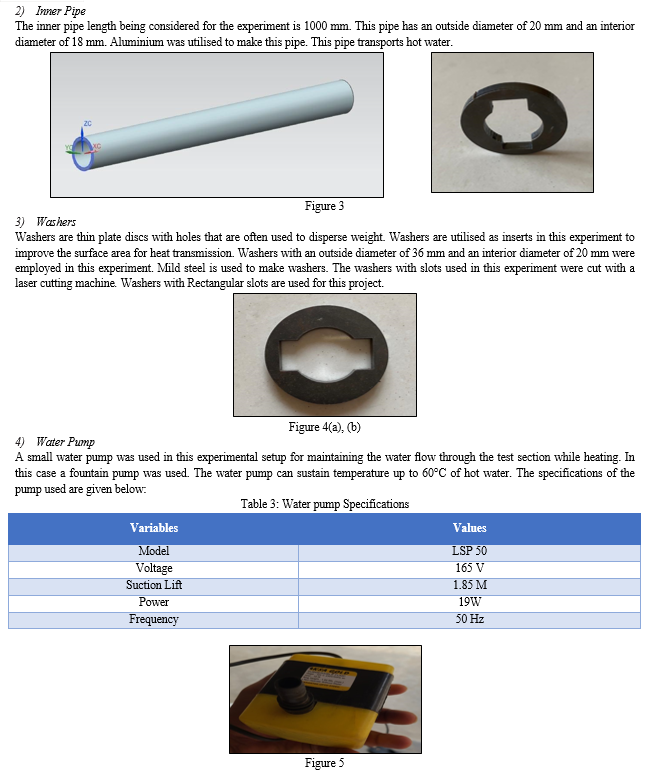
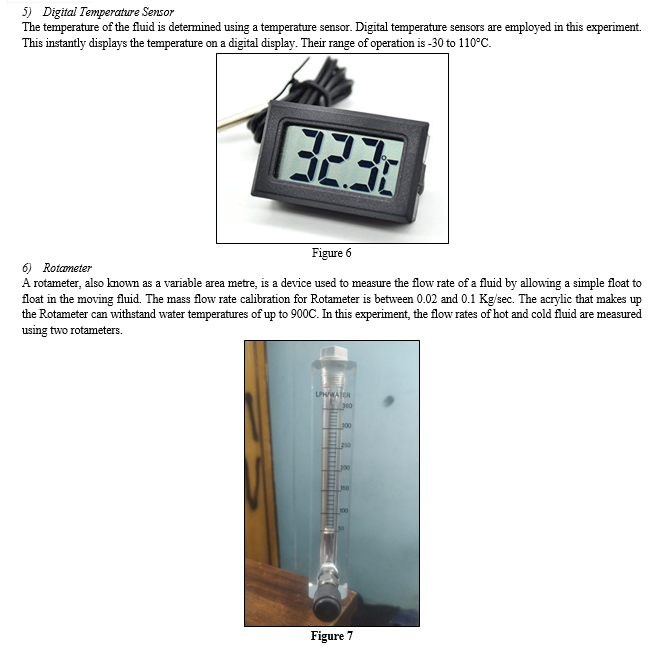
VI. EXPECTED RESULTS
- It is expected that as the mass flow rate of cold fluid as well as hot is altered we observe a change in temperature on the temperature sensor.
- Low mass flow rate/volumetric flow rate: The volumetric flow rate of the water is low which means the volume/mass of water flowing through the pipe section per second is less hence the water molecules will get heated up faster.
- High mass flow rate/volumetric flow rate: If the number of molecules of water flowing through a point is more then it will take more time to heat them. Hence, we can say that the temperature difference, in this case, will be lesser.
Conclusion
In the present study numerical simulation of washer inserted double pipe heat exchanger is done with hot fluid flowing in the inner tube and cold fluid in the annulus. After validating the results for a bare heat exchanger with the experimental results Simulation was done using Rectangular slot configurations inside the washers on the outer body of inner tube. The results indicated washer configurations showed an overall improvement in the thermal characteristics compared with bare one. For better Performance the mass flow rate of the cold fluid should be kept low whereas that of the hot liquid should be high. For a constant value of mc of 0.02 kg/s, as mh was increased, the effectiveness of the washers inserted tube is increased also thermal performance is being increased in counter flow than parallel flow.
References
[1] Ahire, S., Shelke, P., Shinde, B., & Totala, N. (2014). Fabrication and analysis of counter flow helical coil heat exchanger. International Journal of Engineering Trends and Technology (IJETT)–Volume, 15(5), 229-240. [2] Sivakumar, K., & Rajan, K. (2015). Experimental analysis of heat transfer enhancement in a circular tube with different twist ratio of twisted tape inserts. International Journal of Heat and Technology, 33(3), 158-162. [3] Jamra, S., Singh, P. K., & Dubey, P. (2012). Experimental analysis of heat transfer enhancement in circular double tube heat exchanger using inserts. International Journal of Mechanical Engineering & Technology (IJMET), 3(3), 306-314. [4] B. K, Anand & Naveena, H.S. & Nagesh, R. & Cg, Prabhakar. (2017). Experimental investigation for the heat transfer of a double pipe heat exchanger. International Journal of Mechanical Engineering and Technology. 8. 203-210. [5] Mahato, S. K., Rana, S. C., & Barman, R. N. (2021, April). Study of heat transfer enhancement through the non-circular ducts using three dimensional numerical investigations and their comparisons. In IOP Conference Series: Materials Science and Engineering (Vol. 1128, No. 1, p. 012037). IOP Publishing. [6] Jitendra Kolhe, N. N. Bhostekar , & Dr. Kiran Chaudhari. (2017). Heat transfer enhancement in double pipe heat exchanger using washers as an insert. International Journal of Advance Research and Innovative Ideas in Education, 3(4), 2369-2377. [7] Akbarzadeh, Mohsen & Rashidi, Saman & Keshmiri, Amir & Shokri, N.. (2019). The optimum position of porous insert for a double-pipe heat exchanger based on entropy generation and thermal analysis. Journal of Thermal Analysis and Calorimetry. 139. 10.1007/s10973-019-08362-x. [8] Joshi, N. (2021). Simulation and Analysis of Double Pipe Heat Exchanger. International Journal for Research in Applied Science and Engineering Technology, 9(VI), 2388-2394. [9] Kahalerras, H., & Targui, N. (2008). Numerical analysis of heat transfer enhancement in a double pipe heat exchanger with porous fins. International Journal of Numerical Methods for Heat & Fluid Flow. [10] Sivakumar, K., & Rajan, K. (2015). Experimental analysis of heat transfer enhancement in a circular tube with different twist ratio of twisted tape inserts. International Journal of Heat and Technology, 33(3), 158-162.
Copyright
Copyright © 2023 Durwa Chavan, Pratyusha Joshi, Swapnil Wankhede, Aadarsh Shewale, Dr. Usha Pawar. This is an open access article distributed under the Creative Commons Attribution License, which permits unrestricted use, distribution, and reproduction in any medium, provided the original work is properly cited.

Download Paper
Paper Id : IJRASET50728
Publish Date : 2023-04-20
ISSN : 2321-9653
Publisher Name : IJRASET
DOI Link : Click Here
 Submit Paper Online
Submit Paper Online

